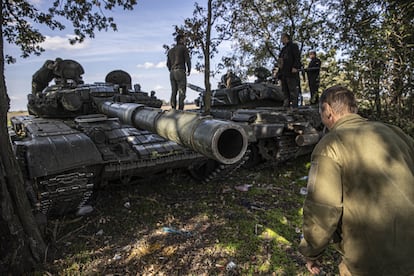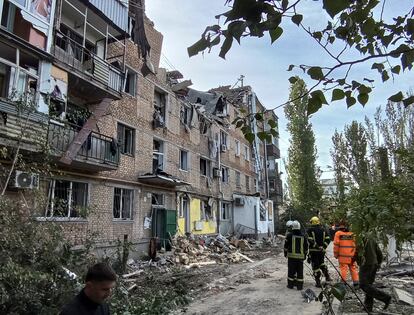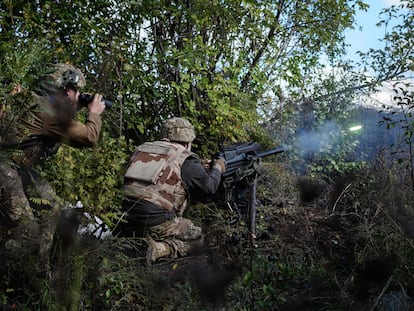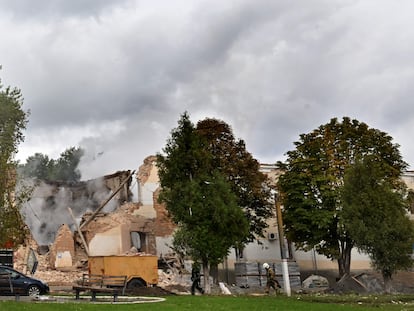Russia prepares evacuation of civilians from Kherson as Ukrainian forces advance
Moscow’s bombing campaign continues to target civilians and critical infrastructure as Kyiv’s counter-offensive seeks to surround the occupied area


The advance of the Ukrainian counter-offensive in the southern region of Kherson has forced the Russian occupying authorities to organize the evacuation of the civilian population. The Kremlin-installed governor of Kherson, Volodymyr Saldo, on Thursday sent a message to Moscow asking for assistance, to which Russian Deputy Prime Minister Marat Khusnullin responded by assuring the official that the government of Vladimir Putin would help to transfer non-combatants to provinces in Russia. Meanwhile, reprisal attacks launched by Russian forces in response to the destruction of the Kerch Bridge in Crimea – the only land link between Russia and the peninsula it illegally annexed in 2014 – have been continuing across Ukraine. For a third consecutive day, Russian missiles targeted civilians and critical infrastructure in up to 40 towns, the Armed Forces of Ukraine stated. On Thursday, Russia announced that repair work on the vital bridge over the Kerch Strait is unlikely to completed before July 2023.
Saldo sent his request to Moscow via a video posted on the Telegram messaging platform while Ukrainian forces continued to make territorial gains in the region. Kyiv confirmed that it liberated five municipalities in Kherson on Thursday, having pushed Russian forces out of another five the previous day. According to the Ukrainian authorities, between October 1 and October 6, Ukrainian counter-offensives resulted in the liberation of 29 towns and villages in an area of around 400 square kilometers (154 square miles) in Kherson. The Ukrainian army is currently advancing on two fronts in the north and south of Kherson in an attempt to surround and cut off Russian forces occupying the eponymous capital of the region.
“We have recommended that all residents of the Kherson region who wish to protect themselves from [Ukrainian] missile attacks move to other regions in Russia,” Saldo said, adding: “Take your children and leave.”
The head of the military-civilian collaborationist administration said evacuations would start with those inhabitants closest to the front line, who are to be moved to Crimea and the Russian provinces of Rostov, Krasnodar and Stavropol.
Shortly after Saldo’s message, the deputy head of the Kherson military-civilian administration, Kirill Stremousov, published another video denying that what Saldo had said amounted to a “call for evacuation” of the region. “Nobody is planning to withdraw Russian troops from the Kherson region,” Stremousov stated. Kherson is strategically important because should Russia lose control of the region, supply lines to Crimea would be severely hindered. As such, Ukrainian forces are targeting Nova Kakhovka, a port city on the east bank of the Dnieper River, to advance on Kherson from the north and cut off access to the canal that serves as Crimea’s main source of water. If Kyiv retakes the administrative capital of Kherson, it can also cut off Crimea’s electricity supply. That would leave the annexed territory completely reliant on its direct link with Russia via the Kerch Strait.
Despite Stremousov’s attempt to play down the gravity of the situation, Khusnullin said that Moscow would heed Saldo’s call: “The government has decided to organize help for the departure of inhabitants from the region to other parts of the country,” the deputy prime minister confirmed on state television. “We will offer everyone free accommodation and whatever they need.”

Russian air strikes hit 40 Ukrainian towns
In retaliation for the attack on the Kerch Bridge, Russia has stepped up its bombing campaign using cruise missiles and Iran-supplied Shahed 136 “suicide” drones. The Armed Forces of Ukraine confirmed that 40 locations had been attacked on Thursday, including civilian targets. At least 26 people have been killed by Russian air strikes since Monday, according to the Kyiv authorities, with 28 electrical supply installations damaged. Meanwhile, the Ukrainian counter-offensive has launched 32 separate attacks against 25 Russian objectives, according to the same sources.
Ukraine has described Russia’s attempts to knock out power supplies to the civilian population ahead of the coming winter as a “war crime.” Energy Minister Herman Haluschenko said on Tuesday that 30% of Ukraine’s energy production and distribution infrastructure had been attacked. On Thursday, the port city of Mykolaiv was targeted. The governor of the unoccupied region, Vitalii Kim, said that Russian air strikes had “reached several civilian targets.” At least three people were killed in the attacks, during which an 11-year-old boy was rescued after six hours under the rubble of a destroyed building, the Ukrainian emergency services said. In Nikopol, power to around 2,000 homes was knocked out after air strikes targeted civilian buildings, gas pipelines and power lines.
Moscow denies targeting civilians
The Kremlin continues to deny that it is deliberately attacking civilian targets, while Kyiv states that Russia is attacking non-combatants and essential infrastructure to “use the cold as a weapon.”
“In their sick minds, Ukrainians spending a few hours without power is a victory,” said Ukrainian Prime Minister Denys Shmyhal in an address to the population to ask for energy saving measures and preparations for a tough winter by stocking up on warm clothes, candles, torches and batteries. The plans of the authorities in Ukraine’s largest cities to guarantee heating this winter via coal and gas have dominated the local media in recent days. As it the case every year, these services will be activated by local administrations in the second half of October, although delays are expected if Russia continues to attack coal mines and processing plants, as was the case on Monday in Kryvyi Rih, the largest city in central Ukraine.
EU extends temporary protection for Ukrainian refugees
The interior ministers of the European Union member states met in Luxembourg on Friday to discuss the situation of Ukrainian refugees who have fled the Russian invasion. Earlier this week, the European Commission proposed an extension to the directive granting temporary protection in the EU to Ukrainian citizens. First activated in March, shortly after the Russian invasion was launched, the commission recommended the measure should run until March 2024. The directive is designed to guarantee immediate protection to people arriving on EU territory and who are unable to return to their countries due to war, violence or violations of human rights. In the case of Ukraine, it allows refugees from the war access to a residency permit, access to the labor market and medical and social benefits.
Tu suscripción se está usando en otro dispositivo
¿Quieres añadir otro usuario a tu suscripción?
Si continúas leyendo en este dispositivo, no se podrá leer en el otro.
FlechaTu suscripción se está usando en otro dispositivo y solo puedes acceder a EL PAÍS desde un dispositivo a la vez.
Si quieres compartir tu cuenta, cambia tu suscripción a la modalidad Premium, así podrás añadir otro usuario. Cada uno accederá con su propia cuenta de email, lo que os permitirá personalizar vuestra experiencia en EL PAÍS.
¿Tienes una suscripción de empresa? Accede aquí para contratar más cuentas.
En el caso de no saber quién está usando tu cuenta, te recomendamos cambiar tu contraseña aquí.
Si decides continuar compartiendo tu cuenta, este mensaje se mostrará en tu dispositivo y en el de la otra persona que está usando tu cuenta de forma indefinida, afectando a tu experiencia de lectura. Puedes consultar aquí los términos y condiciones de la suscripción digital.
More information
Últimas noticias
Maduro pleads not guilty before the federal court in New York: ‘I am still the president of Venezuela’
A new test can detect Alzheimer’s from a finger prick
UN team enters Sudanese city of El Fasher after paramilitary massacre: ‘It’s like a ghost town’
A recipe for resistance: Indigenous peoples politicize their struggles from the kitchen
Most viewed
- Gilles Lipovetsky: ‘If you want to live better and fall in love, take Prozac, don’t look to philosophy’
- Alain Aspect, Nobel laureate in physics: ‘Einstein was so smart that he would have had to recognize quantum entanglement’
- Alvin Hellerstein, a 92-year-old judge appointed by Bill Clinton, to preside over Maduro’s trial in New York
- Why oil has been at the center of Venezuela-US conflicts for decades
- Maduro’s downfall puts China’s relationship with Venezuela to the test










































